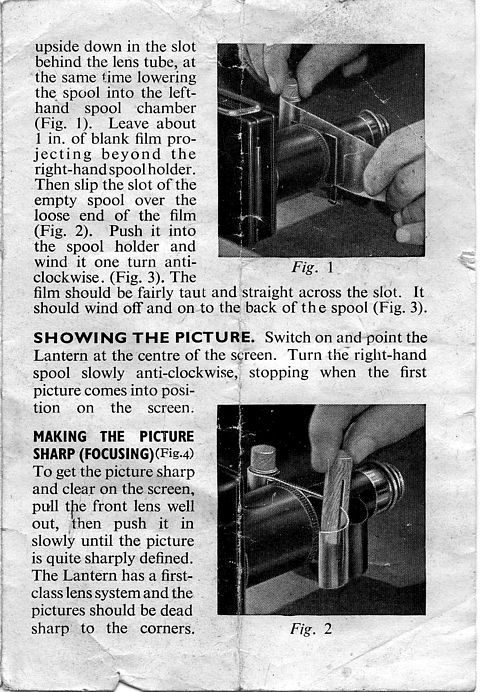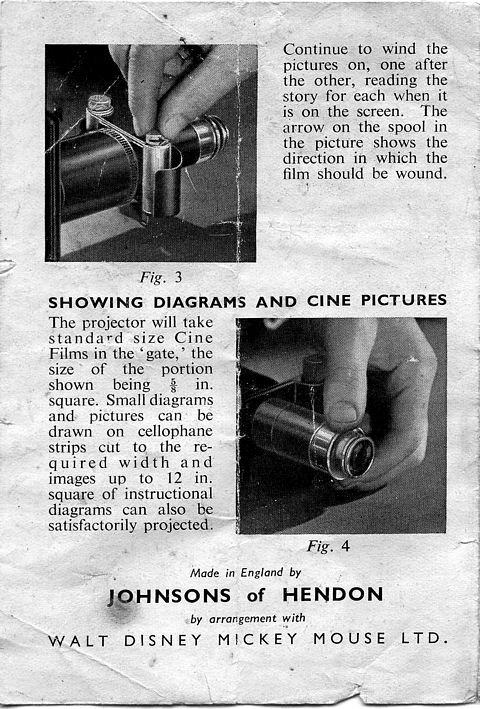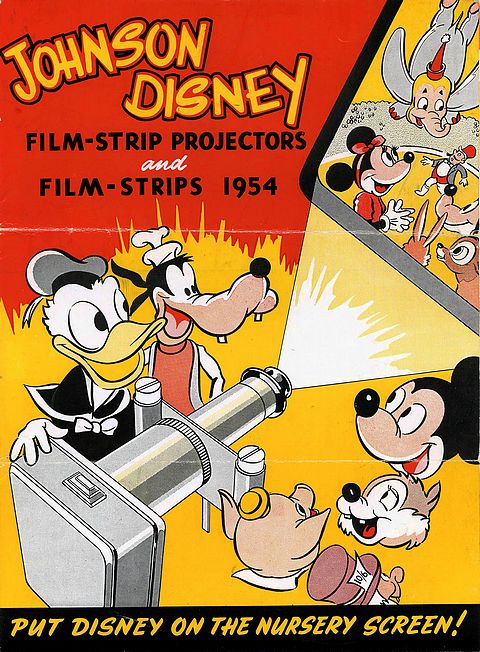| Johnson-Disney Film Strip Projector |
|
|
|
|
From the late 1940s and for several years during the 1950s, Johnsons sold a 4.5volt battery powered toy projector that showed stationary film strip images based upon Walt Disney characters. The version of the projector shown in the advertisement below, taken from an undated Johnsons catalogue but believed to date from 1952 or 1953, is seemingly the 3rd version of this projector. Earlier versions had the switch located on the front plate of the projector body and in the earliest version the projector body also had a metal handle. This suggests the Disney projector was on sale for several years prior to this catalogue publication and recent (September 2020) research by Gavin Ritchie found its origins can be traced back to post World War II from Johnsons, and even the late 1930s from Ensign Ltd. |
|
 |
|
|
presumably in the role of the Sorcerer's Apprentice (composed by Paul Dukas ) |
|
|
Gavin Ritchie has accumulated information on this toy projector from various websites. The Luikerwaal website contains a fascinating history of
magic lanterns. This site page tells us: Gavin also found an extract from the book "Disneyana Walt Disney Collectibles" by Cecil Munsey (1974). Chapter 6 tells us: 6. Walt's Representative
in London Levy had been in England representing Disney for only a few weeks when he began receiving inquiries about the possibilities of using Mickey Mouse on character merchandise. The interest in England closely followed Walt's and older brother Roy's recognition of character merchandising as a possible adjunct to their film business in the United States. On June
17th, 1930, Levy received a power of attorney from Walt that
authorized Levy to license manufacturers to produce merchandise
featuring Mickey and Minnie Mouse. Levy's official merchandising
began five months after that of George Borgfeldt & Co. Unlike
Borgfeldt, however, Levy was ready to quickly launch into the
character merchandising business. He had accumulated all the
paperwork associated with the many enquiries that had come in,
and he quickly met and made deals with many of the firms represented.
By September 14th, 1930, he bad twenty-eight licensees signed. * Throughout the 1930s and until 1941, Fred Butcher was working at Ensign Ltd. During those years, the other company referred to was named Johnson and Sons, Manufacturing Chemists, Ltd; not Johnsons of Hendon, Ltd. The company did not become Johnsons of Hendon, Ltd; until mid to late 1948. |
|
|
During the nights of 24th/25th September 1940, during World War 2, the company of Ensign Ltd (the sales 'wing' of Houghton Butcher; founded in 1834) was destroyed by enemy bombing. On October 7th, Ensign Ltd was wound up and the remaining stock of enlargers, epidiascopes and cine cameras was taken over by Johnson & Sons. Stanley Houghton, previously the General Manager of Ensign and Fred Butcher, the Technical Director, together with other members of staff, joined Johnson and Sons (located in Hendon but only using Johnsons of Hendon as an informal trading name until 1948 when they became Johnsons of Hendon, Ltd). Thereafter, Johnsons continued to supply the services and equipment previously provided by Ensign Ltd. After World War II, the Johnson Disney Toy Projection Lantern (as its name became) was modified to carry filmstrips of twenty-four pictures instead of slides. |
|
|
Thanks to a donation by Keith Cutting of a Mark 1 version in need of repair, and to Gavin Ritchie for his repair skills, the Mark 1, with its top front mounted on/off light switch and folding wire handle, can be seen below. Some of the notes that Gavin made of how the repair was effected, are available to view here. The earlier (late 1930s) Ensign version was much as the Mark 1 from Johnsons, but also had a wire hanging bracket, which was unlikely to be useful for projection but may have simply been a feature of the hand-held torch on which the design was based. The Ensign lantern also had a 'slip in' metal base to stabilise the torch unit and hold the whole thing horizontal during use. This became unnecessary with the Johnsons design due to it having two metal 'legs' below the film 'gate'. |
|
 |
 Complete with a film strip in place for projection, on the wooden hand winding rollers. Notice the two metal legs below the film 'gate' that support and level the projector. |
| The donation from Keith Cutting came with a box of 6 individually boxed film strips, this being Series 49. | |
.jpg) |
.jpg) |
|
The instruction booklet for the Mark 1 can either be viewed as individual pages below, or downloaded as a pdf, here. Page 3 advises "MAKING THE PICTURE SHARP (FOCUSING). To get the picture sharp and clear on the screen, pull the front lens well out, then push it in slowly until the picture is quite sharply defined. The Lantern has a first-class lens system and the pictures should be dead sharp to the corners. |
|
 |
 |
 |
 |
| Further notes from Gavin read: | |
|
I have seen two boxes (on websites specialising in these items) in which the Mark 1 version was sold. The first of these refers to Johnsons of Hendon (see left hand side, below), while the later refers to Johnsons of Hendon Ltd. (see right hand side, below). It was in 1948 that Johnson and Sons, Manufacturing Chemists Limited, changed its name to Johnsons of Hendon Limited, so this second box design (right hand side, below) was introduced on or after that date. Johnsons of Hendon was used in advertising as a trading name for five years before the company (then named Johnson & Sons, Manufacturing Chemists, Ltd) formally changed its name to Johnsons of Hendon Limited. It is likely therefore that the first of these box designs (left hand side, below) dates between 1943 and 1948. Since the instruction leaflet above also refers to simply "Johnsons of Hendon", the Mark 1 design shown above also pre-dates 1948. Note also that in these years the name of the instrument changed from 'Lantern' to 'Projector'. Presumably 'Lantern' was by then an outdated term reminiscent of the 'magic lanterns' used to project glass slides from Victorian times until the 1930's, whilst the 'new' 35mm slides were being shown using projectors. |
|
 |
 |
| The Disney projector is also described in detail on Patrice Guérin's website. The colour images, below, belong to Patrice. | |
 |
|
 |
 |
|
|
|
|
|
|